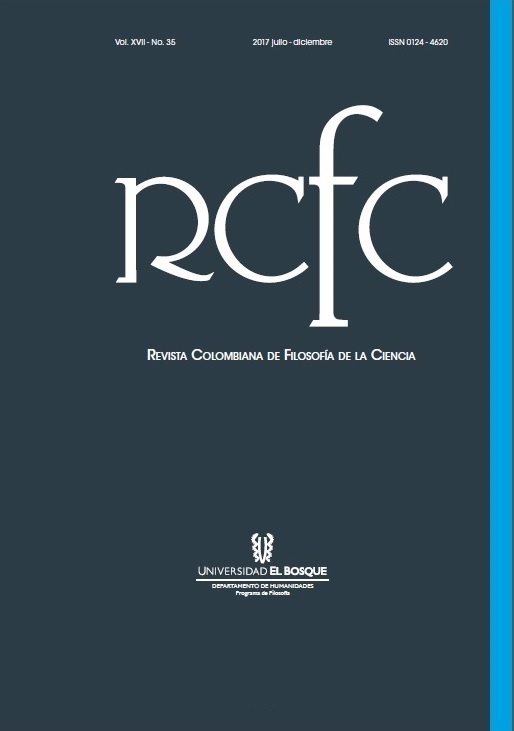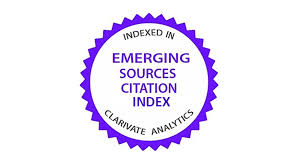Teoría de las cantidades conservadas
Una tensión interna
DOI:
https://doi.org/10.18270/rcfc.v17i35.2328Palabras clave:
causación física, mundos físicamente posibles, necesidad, definición, identidad.Resumen
En su intento de responder a la pregunta acerca de qué es una relación causal, la Teoría de las cantidades conservadas de Phil Dowe define ‘proceso causal’ como ‘línea de mundo de un objeto que posee una cantidad conservada’. Sin embargo, cuando Dowe se enfrenta a críticas plausibles, lo que originalmente se presentaba como una definición adquiere el estatuto de verdad contingente. En el presente trabajo se argumentará que esta tensión puede resolverse en dos direcciones diferentes, según que la identificación entre ‘proceso causal’ y ‘línea de mundo de un objeto que posee una cantidad conservada’ se interprete como una definición o como una mera caracterización, conduciendo a diferentes versiones de la teoría de la causación de Dowe.
Descargas
Referencias bibliográficas
Aronson, J. “On the Grammar of ‘Cause’ ”. Synthese 22 (1971): 414-430.
Cartwright, N. “Causal Laws and Effective Strategies”. Noûs 13 (1979): 419-437.
Choi, S. “The Conserved Quantity Theory of Causation and Closed Systems”. Philosophy of Science 70 (2003): 510-530.
Curiel, E. “The Constraints General Relativity Places on Physicalist Accounts of Causality”. Theoria 15 (2000): 33-58.
Dowe, P. “Process Causality and Asymmetry”. Erkenntnis 37 (1992a): 179-196.
______. “Wesley Salmon’s Process Theory of Causality and the Conserved Quantity Theory”. Philosophy of Science 59 (1992b): 195-216.
______. “Causality and Conserved Quantities: A Reply to Salmon”. Philosophy of Science 62 (1995a): 321-333.
______. “What’s Right and What’s Wrong with Transference Theories”. Erkenntnis 42 (1995b): 363-374.
______. Physical Causation. Cambridge: Cambridge University Press, 2000.
______. “Localismo y explicación causal”. Causación, explicación y contrafácticos. Coord. H. Miguel. Buenos Aires: Prometeo, 2014.
Earman, J. A Primer on Determinism. Dordrecht: Reidel, 1986.
Fair, D. “Causation and the Flow of Energy”. Erkenntnis 14 (1979): 219-250.
Hoefer, C. “Energy Conservation in GTR”. Studies in History and Philosophy of Modern Physics 31 (2000): 187-199.
Lam, V. “Metaphysics of Causation and Physics of General Relativity”. Humana. Mente 13 (2010): 61-80.
Lewis, D. Counterfactuals. Oxford: Blackwell, 1973a.
_____. “Causation”. Journal of Philosophy 70 (1973b): 556-567.
Lupher, T. “A Physical Critique of Physical Causation”. Synthese 167 (2009): 67-80.
Miguel, H. y J. Paruelo. “Causación: análisis empírico vs. análisis conceptual”. Epistemología e Historia de la Ciencia 10 (2004): 401-407.
_____. “Superposición de interacciones causales en la teoría de Phil Dowe”. Enrahonar 37 (2005): 123-139.
_____. “Causar o dejar que ocurra”. Andamios. Revista de Investigación Social 4 (2007): 7-18.
Quezada, W. “Causalidad: teoría, problemas y recomendaciones”. Proyecto Dicyt – Usach. Teorías filosóficas de causalidad física. Santiago de Chile: Universidad de Santiago de Chile, 2000.
_____. “Causalidad física: procesos causales y cantidades conservadas”. Revista de Filosofía 58 (2002): 79-100.
Reichenbach, H. The Philosophy of Space and Time. New York: Dover, 1958.
Rueger, A. “Local Theories of Causation and the a Posteriori Identification of the Causal Relation”. Erkenntnis 48 (1998): 25-38.
Russell, B. “On the Notion of Cause”. Proceedings of the Aristotelian Society 13 (1913): 1-26.
_____. Human Knowledge. New York: Simon and Schuster, 1948.
Salmon, W. Scientific Explanation and the Causal Structure of the World. Princeton: Princeton University Press, 1984.
_____. “Causality without Counterfactuals”. Philosophy of Science 61 (1994): 297-312.
_____. “Causality and Explanation: A Reply Two Critiques”. Philosophy of Science 64 (1997): 461-477.
Suppes, P. A Probabilistic Theory of Causality. Amsterdam: North Holland, 1970.
Vaidya, A. “The Epistemology of Modality” The Stanford Encyclopedia of Philosophy. Ed. E. N. Zalta, 2007. <http://plato.stanford.edu/entries/modality-epistemology/>
Vicente, A. “The Localism of the Conserved Quantity Theory”. Theoria 45 (2002): 563-571.
Descargas
Publicado
Cómo citar
Número
Sección
Licencia
Derechos de autor 2017 Editorial El Bosque

Esta obra está bajo una licencia internacional Creative Commons Atribución-NoComercial-SinDerivadas 4.0.











